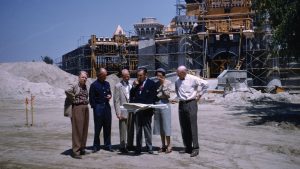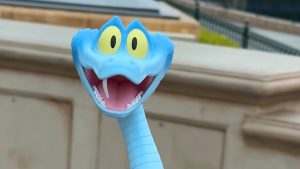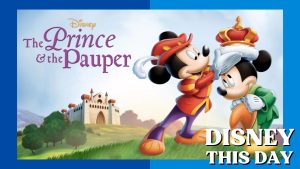Book on Disney artwork focuses on sources of inspiration.
You might think Walt Disney wasn't much like painter Andy Warhol, computer whiz Bill Gates, or poet T.S. Eliot, but you'd be wrong.
Each had a similar approach to innovation, a mindset that other people can see in their own careers, or in people around them.
Each also made an early breakthrough in his chosen field, yet the relevance of their style of innovation isn't limited to being young geniuses. That's especially true of Disney, who extended his achievements into middle age and beyond, stages of life when young geniuses typically falter.
Some of Disney's approach to innovation is evident in the new book "Once Upon a Time Walt Disney," published in conjunction with an exhibit of Disney art that opened last year in Paris and is currently on display in Montreal.
Basically, Disney was an idea man. He began his career as a hands-on cartoonist, but as his company grew he soon became a full-time manager, organizer and inspirer. As Disney expert Pierre Lambert writes in "Once Upon a Time," Disney knew that "the kind of organization he had set up left him no time for drawing, but …he never felt any regrets about the fact, because drawing for him was just a tool to express his ideas."
As an idea man, Disney was a "conceptual innovator," a category defined by David Galenson, a University of Chicago economist who studies the careers of creative people, from artists to entrepreneurs.
Conceptual innovators tend to have a knack for simplifying problems, which they may solve by synthesizing old ideas in ways that no one had thought of before. They're often inspired by works from the past, sometimes borrowing from them, as Disney did in many movies and as Eliot did in citations he sprinkled through many poems, They tend to come up with bold new ideas and make plans to achieve them, which lets them delegate work to assistants, as Disney did with artists starting in the 1920s, as Warhol did with assistants in the 1960s, and as Gates has done since founding Microsoft.
Conceptual innovators also tend to do their best work at a young age. Among them, Gates foresaw the key role of microcomputers' operating systems by the time he founded the company that became Microsoft at age 19. Eliot wrote his most popular poem at age 22. Disney created "Steamboat Willie," the first popular animated film with sound, at age 22. Warhol first made his mark in his 20s as a commercial artist in New York City and shifted to fine arts in his early 30s. His most valued works are from just after that career shift.
In contrast, innovators in Galenson's second category – experimental innovators – tend to do their best work late in their careers. Think of poet Robert Frost writing "Stopping by the Woods on a Snowy Evening" at age 48 or Paul Cezanne doing his most influential paintings in his 60s.
Experimental innovators tend to work by trial and error, without a master plan. Their skills develop gradually over the course of their career. Typically, they're inspired by the world around them, rather than by previous works of art.
SOURCES OF INSPIRATION
Disney's detractors often criticize him as unoriginal because his cartoons tend to be simplified versions of earlier works. But that's how many conceptual innovators work.
Warhol's most familiar artworks are based on pop imagery – Marilyn Monroe, a Campbell's Soup can, Mao, and even Mickey Mouse. Author Conrad Aiken called Eliot a "scholarly plagiarist." Gates, too, is criticized as unoriginal because, for example, he bought rather than wrote the software that became the basis for the first Microsoft operating system.
"Once Upon a Time" focuses on this aspect of Disney's work. True to its subtitle, "The Sources of Inspiration for the Disney Studios," it portrays Disney works and the originals that inspired them. These include:
•Mickey Mouse and company, along with personable animals drawn in the 1850s by French artist Honoré Daumier and in the early 1900s by British illustrator Beatrix Potter.
Modestly clothed Tinker Bell next to a nude winged goddess by 19 {+t}{+h}-century British painter John Atkinson Grimshaw.
The witch from "Snow White" with her look-alikes – a 1940 publicity photo of American actress Joan Crawford and a statue of a queen from a Gothic cathedral in Germany.
The devil from the "Night on Bald Mountain" segment of "Fantasia," with an 1826 scene from hell by British artist/poet William Blake and a movie still from F.W. Murnau's 1926 film "Faust."
King Stefan's castle from "Sleeping Beauty" of 1959 next to a castle scene from Laurence Olivier's 1944 film "Henry V," which in turn was inspired by medieval paintings.
Snow White in her glass coffin, attended by Disney's three cute dwarves. A comparable 1912 painting by American illustrator Maxfield Parrish portrays Snow White guarded by a grim dwarf.
AVOIDING A RUT
"Once Upon a Time" doesn't get to the latter part of Disney's life, which is potentially the most useful as a model for modern-day conceptual innovators. In middle age, Disney found a way to break free from the mold of a career that trails off after a brilliant start.
To escape that rut, Disney and a few other conceptual innovators made career shifts that let them start afresh. It's a tactic that could help any idea person. In fact, for conceptual innovators, unlike experimental innovators, a midlife crisis can be useful.
That's what Samuel Morse found in the 19 {+t}{+h}century. After decades of struggling, he abandoned a career as a painter in midlife and soon invented the telegraph. He was 48 when he applied for the patent for Morse code and 53 when his new telegraph line carried the message, "What hath God wrought!"
Yet Disney outdoes Morse as an example of the advantages of starting afresh.
"Disney was clearly a conceptual guy," Galenson says. "He was a very driven conceptual innovator who continued to challenge himself." He kept shifting his focus, from cartoons to movies to television to amusement parks.
At age 36, he premiered the first full-length animated movie, "Snow White." At 52, he launched his television series. At age 53, he opened Disneyland, and before his death at 65 he'd begun work on Disney World.
Instead of settling into a single career – or even two careers separated by a mid-life crisis – Disney continually reinvented himself. That approach to innovation is his legacy, just as much as his theme parks and his movies.
Contact the writer: cstewart@ocregister.com or 714-796-7841





